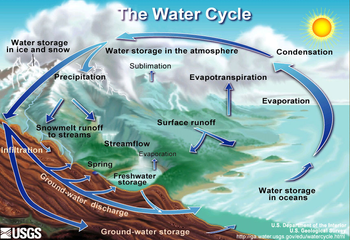The Global Energy and Water Exchanges Project (abbreviated GEWEX, formerly named the Global Energy and Water Cycle Experiment from 1990 to 2012[1]) is an international research project and a core project of the World Climate Research Programme (WCRP).

In the beginning, the project intended to observe, comprehend and model the Earth's water cycle. The experiment also observes how much energy the Earth receives, and studies how much of that energy reaches the surfaces of the Earth and how that energy is transformed. Sunlight's energy evaporates water to produce clouds and rain and dries out land masses after rain. Rain that falls on land becomes the water budget which can be used by people for agricultural and other processes.
GEWEX is a collaboration of researchers worldwide to find better ways of studying the water cycle and how it transforms energy through the atmosphere.[2] If the Earth's climates were identical from year to year, then people could predict when, where and what crops to plant. However, the instability created by solar variation, weather trends, and chaotic events creates weather that is unpredictable on seasonal scales. Through weather patterns such as droughts and higher rainfall these cycles impact ecosystems and human activities. GEWEX is designed to collect a much greater amount of data, and see if better models of that data can forecast weather and climate change into the future.
- ^ "GEWEX News Vol. 22, No. 3, August 2012" (PDF). Archived (PDF) from the original on 2021-04-16. Retrieved 2019-05-03.
- ^ About GEWEX Archived 2015-04-07 at the Wayback Machine, Global Energy and Water Cycle Experiment, World Climate Research Programme, Access date 06-22-2008